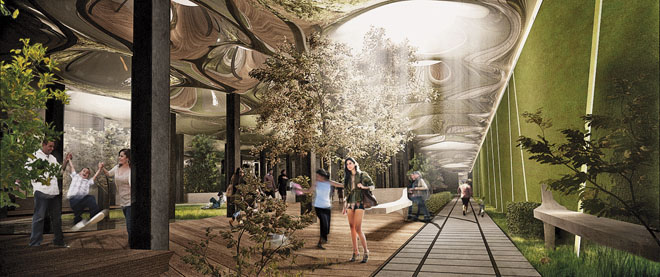New York’s ‘Lowline’ project: a radical idea for a subterranean park
The Delancy Underground project proposes to channel sunlight underground
Share

In a city as dense as New York, architects and urban designers look to rooftops, abandoned buildings, and even obsolete elevated railways to create new public spaces. Architect James Ramsey and his partner Dan Barasch have a new idea that’s exciting the design community’s imagination: they want to turn a defunct, underground streetcar terminal into a park using solar technology. The Delancey Underground project—named after the street that runs above it—would employ a simple system of fibre optic cables to channel enough sunlight underground to support plant and tree growth.
“It’s kind of like irrigating the sunlight,” says Ramsey, a former satellite engineer with NASA. “We’ll concentrate sunlight at the surface, channel it down and redistribute it underground.” Projected animations of the public green space show thriving trees and plant life, a pond, park benches and a futuristic ceiling that simulates the sky. The sunlight would pour in through what looks like upside-down satellite dishes. The technology, which Ramsey invented, is called the “remote skylight.” “We’ve taken out the UV and the infrared,” he says. “So you won’t get a tan down there, but you won’t get a sunburn either.” Ramsey had been “fiddling” with the technology for a few years when he met a city engineer who mentioned that there are nearly 30 unused spaces in the underground transit system. When it occurred to Ramsey that his design could support photosynthesis, the green angle sprang to life.
Above the abandoned terminal, grimy, grey housing projects line the streets, along with dilapidated tenements, piles of shops and bumper-to-bumper traffic. “Most people didn’t even know the space existed,” says Bob Zuckerman, executive director of the Lower East Side Business Improvement District and an official supporter. “We think it will do wonders for the Lower East Side, both for the residents, who can use it as park space, and for our businesses, because it would attract so much foot traffic.” Zuckerman is planning to introduce Ramsey and his co-founder to BID members in the community to get more support for the project.
And funding is exactly what the Delancey Underground needs. So far, the project has raised $134,000 on Kickstarter.com from 2,500 backers. The goal is $300,000 to conduct engineering studies and install the remote skylights in a big warehouse in September to demonstrate the project’s feasibility. Supporters hope this will attract bigger sponsors, who will help fund the cost of building the park, which will likely be in the tens of millions. At this point, there’s no guarantee it will see the light of day—it’s up to the Metropolitan Transit Authority, which owns the space, to issue a request for proposals and approve development. Given that the space, built in 1903, has been untouched since 1948, Ramsey and Barasch hope they have a good shot. But, “at the end of the day, it’s still a piece of real estate in New York City,” says Ramsey.
“There’s no reason, besides funding and political will, that it couldn’t be built tomorrow,” says Galia Solomonoff, an architect and Columbia University professor whose credits include the much-lauded contemporary art museum Dia: Beacon. “It’s absolutely feasible from an engineering and architectural point of view.” Solomonoff participated in the Highline project, which transformed an elevated railway along the waterfront into a landscaped pedestrian park, one of New York’s hottest new tourist attractions. The Delancey Underground has been nicknamed the “Lowline” for its similarities. “It has the public space component,” Solomonoff adds. “The primary benefactor will not be a private entity or group, but the city at large. It also doesn’t interfere with the existing space around it.”
Indeed, the team hopes to incorporate existing structures into the design. Barasch points to the preservationist aspect of the project, explaining how they plan to incorporate remnant cobblestones, trolley tracks and columns into the space. “It’s a little science fiction and futuristic,” he says. “But I think it’s time for us to have some big ideas on how we transform some of our existing underground spaces.”